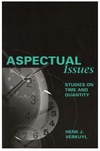

|
|
|
|

Aspectual IssuesStudies on Time and Quantity How does atemporal quantity as expressed by isolated noun phrases, like four tables, some sandwiches, many books, get into time structure as expressed in sentences containing dynamic verbs like lift, eat and read? Does she lifted four tables mean ‘all four tables at once’, or ‘one by one’, or does it allow other configurations? Which principle governs the choice between a 3×4 (twelve tables lifted)—and a 1×4 (four tables lifted)—interpretation of Three girls lifted four tables? These questions follow from the study of the very complex construal of time structure on the basis of quantity information expressed in noun phrases and of information contributed by verbs. This collection is a follow-up to Verkuyl's well-known 1993 volume, A Theory of Aspectuality, explaining and simplifying the exposition of his 1993 theory. The papers collected here also explore the consequences of this theory for a number of areas. In particular, Verkuyl addresses issues in the following areas: habituality; the role of aspectualizers marking the beginning, middle or end of events; the interaction between tense and aspectuality; the role of temporal Path structure in distributive and collective quantification; and the differences and correspondences in the ways in which Slavic, Germanic and Romance languages express aspectuality. Several papers contain a critical analysis of Davidson's event semantics. Verkuyl's critique suggests that neo-Davidsonians either use the wrong tools for a proper analysis of aspectuality, or that they need to adopt some of the crucial assumptions of his theory—in particular, the asymmetry inherent to aspectual construal and his consequent plea to take numbers, rather than events, as the primitives structuring our concept of time. This volume presents one of the most prominent aspectual theories, offering a unified approach to the study of quantification and time structure. is a professor of linguistics at Utrecht University in The Netherlands. Contents
7/1/99 ISBN (Paperback): 157586200X (9781575862002)
Subject: Linguistics; Grammar—Aspect; Grammar—Tense
|
Distributed by the
University of Chicago Press |
|
pubs @ csli.stanford.edu
|
CSLI Publications
Stanford University Cordura Hall 210 Panama Street Stanford, CA 94305-4101 (650) 723-1839 |